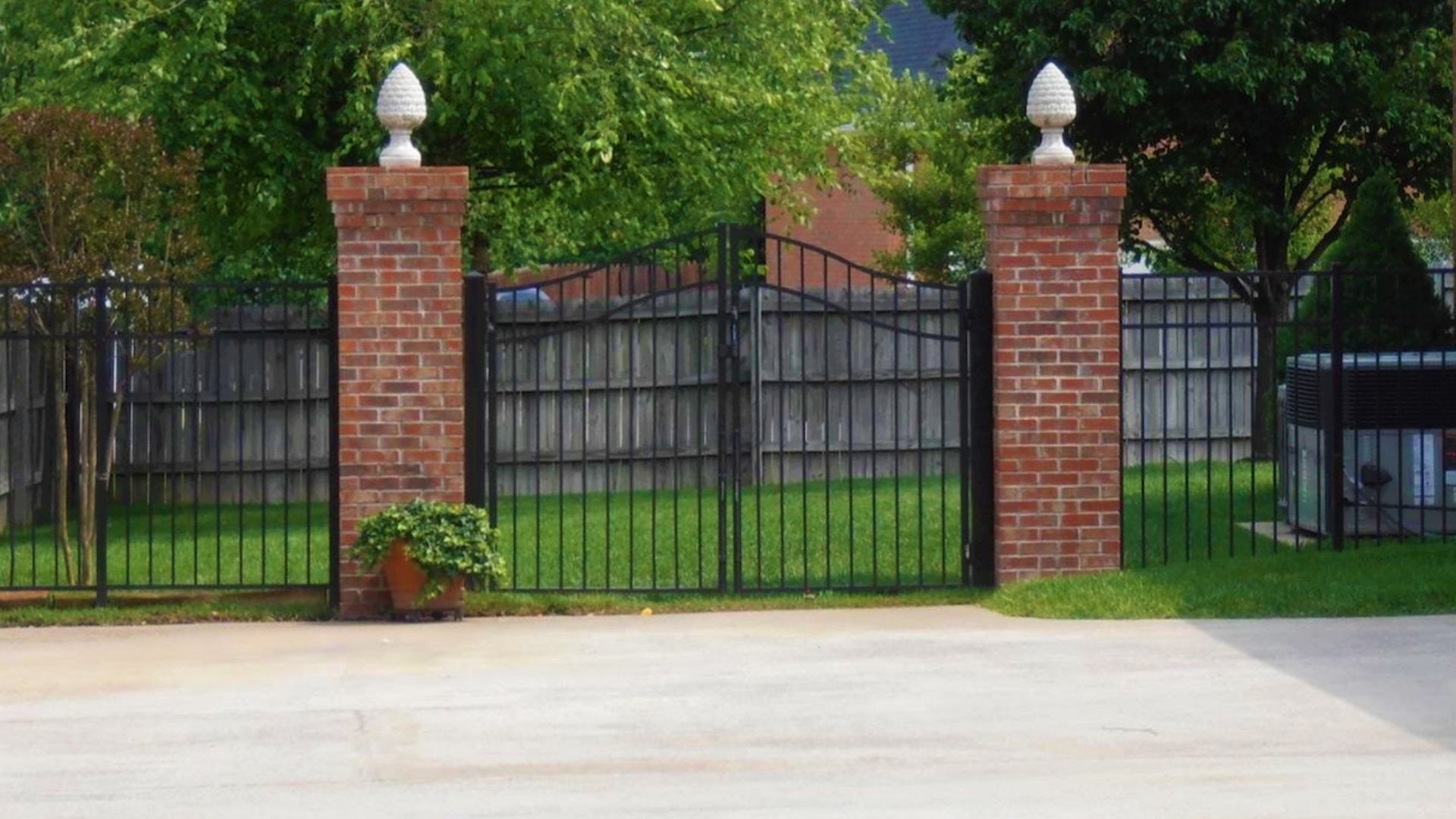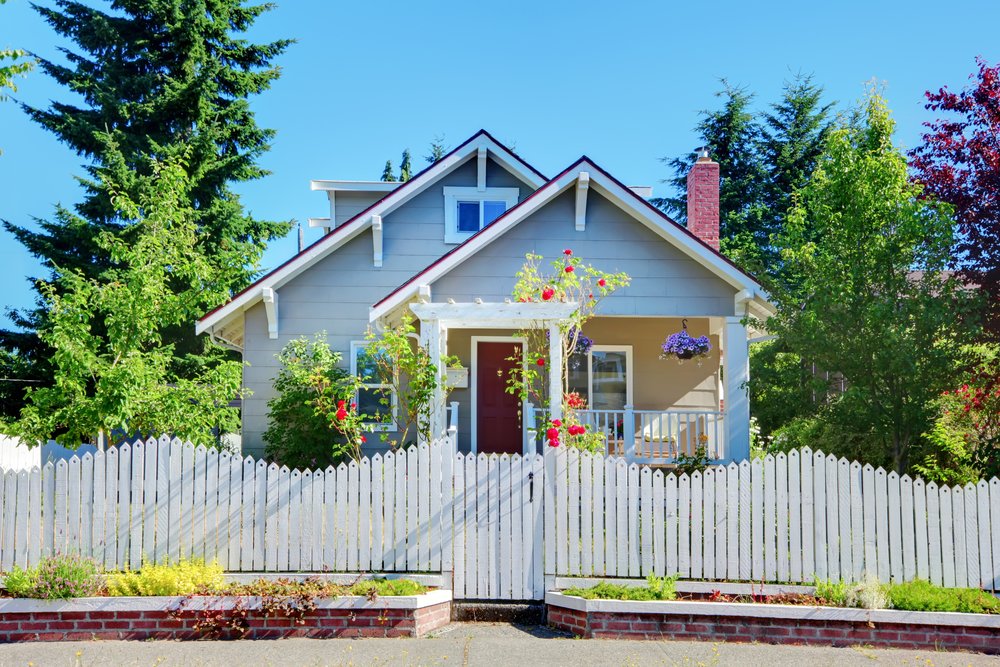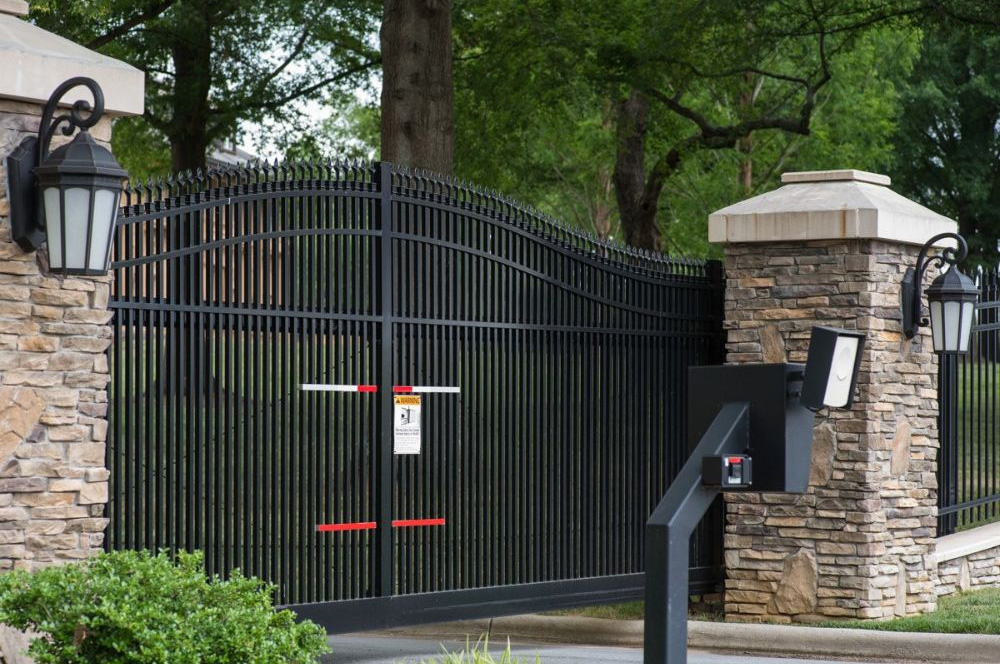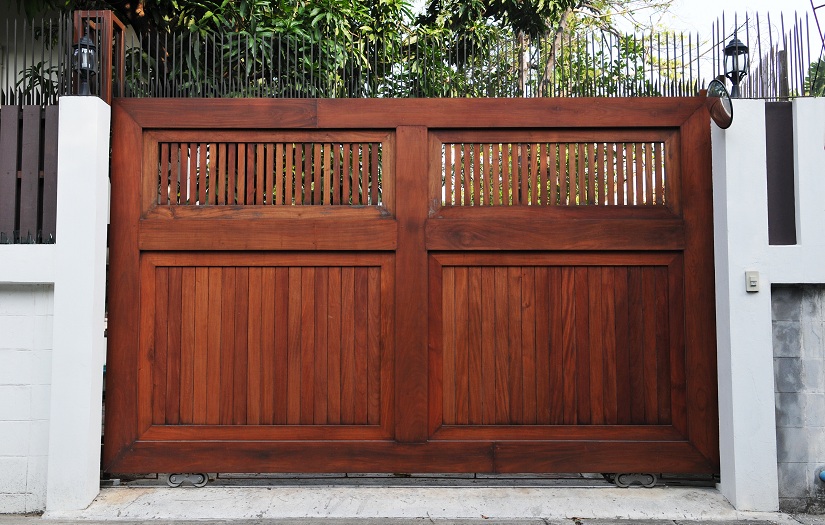Contents
I. Introduction

Welcome to the world of home security fences! In this article, we will explore the numerous benefits of installing a home security fence. Whether you live in a bustling city or a peaceful suburban neighborhood, a home security fence can provide you with peace of mind and enhance the safety of your property.
Home security fences are designed to deter intruders and protect your home from unauthorized access. They act as a physical barrier, making it difficult for potential burglars to enter your property. With the increasing rates of crime, investing in a home security fence is a proactive step towards safeguarding your loved ones and your belongings.
Not only do home security fences provide protection, but they also offer privacy. By installing a fence around your property, you can create a secure and secluded space for you and your family. Enjoy your outdoor activities without worrying about prying eyes or unwanted visitors.
Another advantage of home security fences is their aesthetic appeal. With a wide range of styles, materials, and colors available, you can choose a fence that complements the architectural design of your home. A well-designed fence can enhance the curb appeal of your property and increase its value.
Furthermore, home security fences can act as a deterrent for wildlife and stray animals. If you live in an area prone to wildlife intrusion or have concerns about your pets wandering off, a fence can provide a safe boundary for both your family and your furry friends.
II. Types of Home Security Fences

When it comes to protecting your home and ensuring the safety of your loved ones, installing a home security fence is a wise decision. Not only does it act as a physical barrier, but it also serves as a deterrent to potential intruders. There are several types of home security fences available in the market, each with its own set of advantages and disadvantages. In this section, we will explore the different types of home security fences and their features.
A. Chain-link fences
Chain-link fences are one of the most popular choices for home security. They are made of galvanized steel wires that are woven together to form a diamond pattern. These fences are durable, affordable, and low-maintenance, making them a practical option for homeowners.
Chain-link fences offer visibility, allowing you to keep an eye on your property while maintaining a sense of security. They are also versatile and can be customized to fit any size or shape of the property. Additionally, chain-link fences are resistant to rust and corrosion, ensuring their longevity.
However, one drawback of chain-link fences is their lack of privacy. The open design makes it easy for outsiders to see inside your property. To address this, you can opt for privacy slats or add vegetation such as shrubs or vines to create a more secluded environment.
B. Wooden fences
Wooden fences are a classic choice for home security. They offer both privacy and aesthetic appeal, making them a popular option for homeowners. Wooden fences can be constructed using various types of wood, such as cedar, pine, or redwood, each with its own unique characteristics.
Wooden fences provide excellent privacy, blocking the view from outside and creating a secure space for your family. They can also be customized to match the architectural style of your home, adding value to your property. Additionally, wooden fences are relatively easy to repair and maintain.
However, wooden fences require regular maintenance to prevent rotting, warping, or insect infestation. They should be stained or painted periodically to protect the wood from the elements. It’s also important to note that wooden fences may not be as durable as other materials and may need to be replaced over time.
C. Vinyl fences
Vinyl fences are gaining popularity in the home security market due to their durability and low maintenance requirements. Made from PVC (polyvinyl chloride), vinyl fences are resistant to rot, fading, and discoloration, making them an excellent long-term investment.
Vinyl fences come in a variety of styles, including privacy, picket, and post-and-rail, allowing you to choose the design that best suits your needs. They are available in different colors, eliminating the need for painting or staining. Vinyl fences are also easy to clean, requiring only occasional washing with soap and water.
One downside of vinyl fences is their higher upfront cost compared to other materials. However, considering their longevity and low maintenance requirements, they can be a cost-effective option in the long run. It’s important to choose high-quality vinyl fences to ensure their durability and resistance to extreme weather conditions.
D. Wrought iron fences
Wrought iron fences are known for their elegance and strength. These fences are made from iron that is forged and shaped into intricate designs. Wrought iron fences provide excellent security and can enhance the overall appearance of your property.
One of the key advantages of wrought iron fences is their durability. They are resistant to rust and can withstand harsh weather conditions, making them suitable for both residential and commercial properties. Wrought iron fences also offer high visibility, allowing you to keep an eye on your surroundings.
However, wrought iron fences require regular maintenance to prevent rusting. They need to be painted or coated with a protective finish to maintain their appearance and longevity. Additionally, wrought iron fences can be more expensive compared to other options, especially for larger properties.
E. Electric fences
Electric fences provide an additional layer of security for your home. These fences are equipped with an electric current that delivers a mild shock to anyone who attempts to touch or climb over the fence. Electric fences are commonly used in high-security areas or properties with valuable assets.
The main advantage of electric fences is their ability to deter intruders effectively. The electric shock serves as a strong deterrent, preventing unauthorized access to your property. Electric fences can be customized to suit your specific security needs, with adjustable voltage settings and additional features such as alarms or monitoring systems.
It’s important to note that electric fences should be installed by professionals to ensure their proper functioning and compliance with local regulations. They should also be clearly marked with warning signs to prevent accidental contact. Electric fences may not be suitable for all residential properties, and their installation should be carefully considered.
III. Factors to Consider When Choosing a Home Security Fence

When it comes to protecting your home and ensuring the safety of your loved ones, installing a home security fence is a crucial step. However, with so many options available in the market, choosing the right fence can be a daunting task. In this section, we will discuss the key factors to consider when selecting a home security fence.
A. Security Level
The primary purpose of a home security fence is to provide protection and enhance the security of your property. Therefore, the security level offered by the fence should be a top consideration. Look for fences that are specifically designed for security purposes, such as high-security fences or anti-climb fences. These types of fences are typically made of durable materials and have features like reinforced panels and anti-cut properties, making it difficult for intruders to breach.
Additionally, consider the height of the fence. A taller fence can act as a deterrent and make it harder for unauthorized individuals to access your property. It is recommended to choose a fence that is at least six feet tall to ensure maximum security.
B. Durability
A home security fence is a long-term investment, so it is essential to choose a fence that is durable and built to withstand various weather conditions. Look for fences made from high-quality materials such as steel, aluminum, or wrought iron, as these materials are known for their strength and durability.
Consider the maintenance requirements of the fence as well. Opt for fences that are low-maintenance and resistant to rust, corrosion, and fading. This will save you time and money in the long run, as you won’t have to worry about constant repairs or repainting.
C. Maintenance Requirements
Keeping your home security fence in good condition is crucial for its effectiveness. Therefore, it is important to consider the maintenance requirements of the fence before making a decision. Some fences may require regular cleaning, painting, or treatments to maintain their appearance and functionality.
If you prefer a low-maintenance option, consider fences that are resistant to rust, rot, and other forms of damage. Vinyl and composite fences are popular choices for their minimal maintenance needs. They can be easily cleaned with soap and water, and they do not require painting or staining.
D. Aesthetics
While the primary purpose of a home security fence is security, it is also important to consider the aesthetic appeal of the fence. After all, the fence will be a prominent feature of your property’s exterior. Look for fences that complement the architectural style of your home and enhance its curb appeal.
There are various design options available, ranging from traditional wrought iron fences to modern aluminum or vinyl fences. Consider the color, texture, and overall design of the fence to ensure it blends seamlessly with your home’s aesthetics.
E. Cost
Cost is an important factor to consider when choosing a home security fence. Set a budget and explore different options within your price range. Keep in mind that while it may be tempting to opt for a cheaper fence, compromising on quality and security may end up costing you more in the long run.
Consider the upfront cost of the fence, as well as any additional expenses such as installation, maintenance, and repairs. It is advisable to get quotes from multiple fence contractors to compare prices and ensure you are getting the best value for your money.
IV. Benefits of Installing a Home Security Fence

When it comes to protecting your home and ensuring the safety of your loved ones, installing a home security fence is a wise investment. Not only does it provide enhanced security and deterrence, but it also offers a range of other benefits that can greatly improve your quality of life. In this section, we will explore the various advantages of having a home security fence in place.
A. Enhanced security and deterrence
One of the primary benefits of installing a home security fence is the enhanced security it provides. A sturdy fence acts as a physical barrier, making it more difficult for intruders to gain access to your property. It serves as a deterrent, signaling to potential burglars that your home is well-protected and not an easy target.
Moreover, a security fence can be equipped with additional features such as electronic gates, surveillance cameras, and motion sensors, further bolstering the security of your property. These modern advancements allow you to monitor and control access to your home, giving you peace of mind even when you’re away.
B. Privacy protection
Privacy is a fundamental aspect of any home, and a security fence plays a crucial role in preserving it. By installing a fence around your property, you create a private sanctuary where you can enjoy your personal space without the prying eyes of neighbors or passersby.
Whether you’re relaxing in your backyard, hosting a gathering with friends and family, or simply going about your daily activities, a security fence provides a sense of seclusion and tranquility. It acts as a physical barrier, shielding your home and outdoor areas from unwanted attention and ensuring your privacy is respected.
C. Property value increase
Installing a home security fence not only enhances the safety and privacy of your property but also adds value to your home. Potential buyers are often willing to pay a premium for homes that come with security features already in place, as it saves them the time and expense of having to install a fence themselves.
Furthermore, a well-maintained and aesthetically pleasing security fence can significantly improve the curb appeal of your home. It creates a positive first impression and makes your property stand out in the neighborhood. This increased curb appeal can attract more potential buyers and ultimately lead to a higher selling price if you ever decide to put your home on the market.
D. Noise reduction
In addition to providing security and privacy, a home security fence can also help reduce noise pollution. If you live in a busy neighborhood or near a main road, you’re likely familiar with the constant noise from traffic, neighbors, or other external sources.
A well-constructed fence acts as a sound barrier, absorbing and deflecting noise waves, thereby reducing the amount of noise that reaches your property. This can create a more peaceful and serene environment within your home, allowing you to relax and enjoy a quieter living space.
E. Safety for children and pets
For families with children and pets, safety is a top priority. A home security fence provides an added layer of protection, ensuring that your little ones and furry friends can play and explore the outdoor areas of your property without the risk of wandering off or encountering potential dangers.
With a security fence in place, you can create a secure and controlled environment where your children and pets can safely enjoy the outdoors. It gives you peace of mind, knowing that they are protected from external hazards such as traffic, strangers, or wild animals.
V. How to Install a Home Security Fence

Installing a home security fence is a crucial step in ensuring the safety and protection of your property. Not only does it act as a deterrent for potential intruders, but it also provides privacy and peace of mind for homeowners. In this section, we will guide you through the process of planning, obtaining permits, preparing the site, installing fence panels, securing fence posts, and adding gates and access control systems.
A. Planning and Design
Before you start installing a home security fence, it’s important to plan and design the layout carefully. Consider the purpose of the fence, whether it’s to keep intruders out, protect children and pets, or simply enhance the aesthetics of your property. Measure the perimeter of your property and determine the height and material of the fence that suits your needs.
When planning the design, take into account any local regulations or homeowners association guidelines that may dictate the type of fence you can install. Consider factors such as visibility, maintenance requirements, and compatibility with existing landscaping.
It’s also essential to mark the boundaries of your property accurately. Use surveying tools or consult a professional surveyor to ensure that the fence is installed within your property lines.
B. Obtaining Necessary Permits
Before you proceed with the installation, check with your local building department to determine if you need any permits for installing a home security fence. Permit requirements vary depending on your location and the type of fence you plan to install.
Submit the necessary documents, including your property survey, fence design plans, and any other required paperwork, to the building department. Pay any applicable fees and wait for the permit to be approved before starting the installation process.
C. Preparing the Site
Once you have obtained the necessary permits, it’s time to prepare the site for fence installation. Clear any vegetation, debris, or obstacles along the fence line. Ensure that the ground is level and free from any obstructions that may hinder the installation process.
Identify and mark the locations where the fence posts will be installed. Use a string line or chalk to create a straight and even guideline for positioning the posts. Dig holes for the posts, ensuring that they are deep enough to provide stability and support for the fence.
D. Installing the Fence Panels
With the site prepared, it’s time to install the fence panels. Start by attaching the panels to the fence posts using screws or nails. Ensure that the panels are aligned properly and securely fastened to the posts.
If you are using pre-made fence panels, follow the manufacturer’s instructions for installation. If you are building a custom fence, measure and cut the panels to fit the desired length and height. Use a level to ensure that the panels are straight and plumb.
Consider adding reinforcements such as horizontal rails or crossbars to enhance the strength and stability of the fence. This is especially important for taller or heavier fence panels.
E. Securing the Fence Posts
Securing the fence posts is crucial to ensure the stability and longevity of the fence. Fill the holes around the posts with concrete or gravel to provide a solid foundation. Use a post level to ensure that the posts are straight and level before the concrete or gravel sets.
Allow the concrete or gravel to cure according to the manufacturer’s instructions before proceeding with the installation. This will ensure that the fence posts are securely anchored in place.
F. Adding Gates and Access Control Systems
To complete the installation of your home security fence, you may want to add gates and access control systems. Gates provide entry and exit points while maintaining the security of your property.
Choose a gate design that complements the overall aesthetics of your fence. Consider the size, material, and locking mechanism that best suits your needs. Install the gate according to the manufacturer’s instructions, ensuring that it operates smoothly and securely.
If you want to enhance the security of your fence, consider adding access control systems such as keypads, intercoms, or card readers. These systems provide an additional layer of protection and control over who can enter your property.
Remember to test the functionality of the gates and access control systems before considering the installation process complete.
Installing a home security fence requires careful planning, preparation, and execution. By following the steps outlined in this section, you can ensure that your property is well-protected and secure. Remember to adhere to local regulations, obtain necessary permits, and consult professionals if needed. With a properly installed home security fence, you can enjoy the benefits of enhanced safety, privacy, and peace of mind.
VI. Maintenance Tips for Home Security Fences
When it comes to home security, installing a fence is a smart investment. Not only does it provide a physical barrier to deter intruders, but it also adds privacy and enhances the overall aesthetics of your property. However, like any other feature of your home, a security fence requires regular maintenance to ensure its longevity and effectiveness. In this section, we will discuss some essential maintenance tips to keep your home security fence in top shape.
A. Regular cleaning and inspection
Regular cleaning and inspection are crucial to maintaining the functionality and appearance of your home security fence. Over time, dirt, dust, and grime can accumulate on the surface, making it look worn out and reducing its effectiveness. To clean your fence, start by removing any loose debris using a brush or broom. Then, use a mild detergent mixed with water to scrub away stubborn stains. Rinse thoroughly with water and allow it to air dry. While cleaning, make sure to inspect the fence for any signs of damage, such as loose or broken panels, rust, or corrosion.
B. Repairing damaged sections
If you notice any damaged sections during your inspection, it’s essential to address them promptly. Repairing damaged sections not only restores the security of your fence but also prevents further deterioration. Depending on the extent of the damage, you may need to replace individual panels, fix loose screws or nails, or reinforce weak spots. It’s recommended to consult a professional if you’re unsure how to proceed or if the damage is extensive.
C. Painting or staining
Painting or staining your home security fence not only enhances its appearance but also provides an additional layer of protection against the elements. Before painting or staining, make sure to clean the fence thoroughly and allow it to dry completely. Choose a high-quality paint or stain that is specifically formulated for outdoor use and offers UV protection. Apply the paint or stain evenly, following the manufacturer’s instructions. Regularly inspect the painted or stained surface for any signs of peeling or fading and touch up as necessary.
D. Preventing rust or corrosion
Rust and corrosion can significantly weaken the structural integrity of your home security fence. To prevent rust or corrosion, it’s important to take proactive measures. Start by applying a rust-resistant primer to the metal components of your fence. This creates a protective barrier against moisture and prevents the formation of rust. Additionally, consider using a rust-inhibiting paint or coating for added protection. Regularly inspect the fence for any signs of rust or corrosion and address them immediately to prevent further damage.
E. Trimming vegetation around the fence
Overgrown vegetation can pose a threat to the security and integrity of your home security fence. Plants, such as vines or shrubs, can entangle themselves in the fence, leading to damage or even providing a convenient foothold for intruders. Regularly trim and maintain the vegetation around your fence to ensure a clear and unobstructed perimeter. Trim branches that are hanging over the fence and remove any plants that are growing too close to it. This not only prevents damage but also improves the visibility and effectiveness of your security fence.
By following these maintenance tips, you can ensure that your home security fence remains in optimal condition for years to come. Remember, regular cleaning, inspection, and timely repairs are key to preserving the functionality and appearance of your fence. Additionally, painting or staining, preventing rust or corrosion, and trimming vegetation are essential steps to enhance the longevity and effectiveness of your home security fence.
